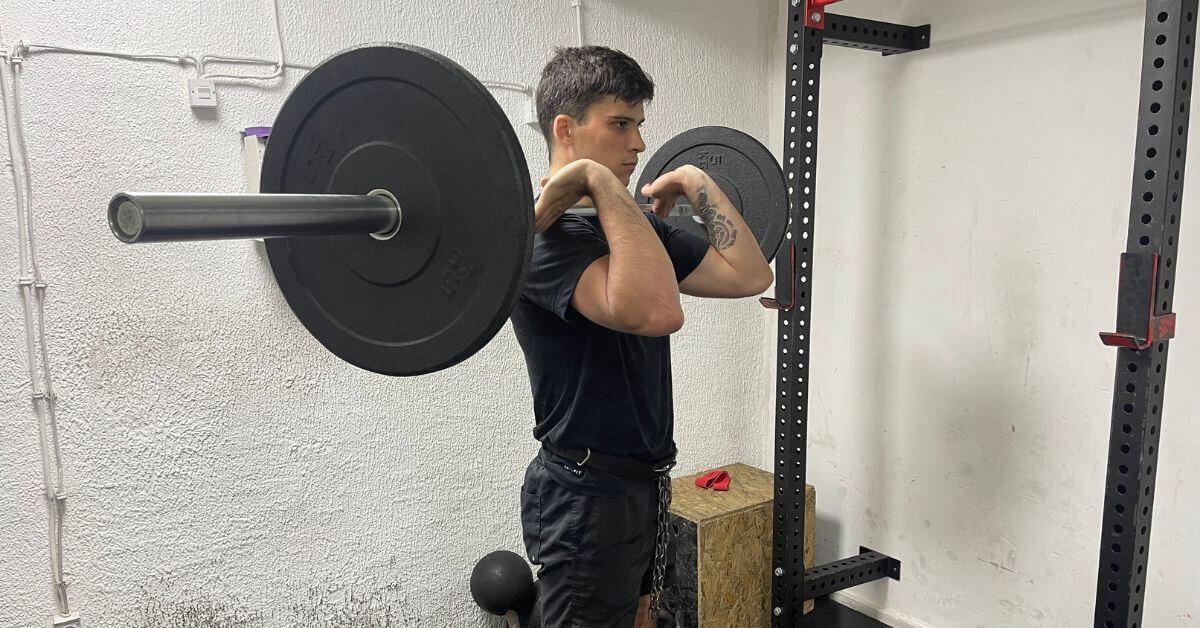Being one of the body’s most complex and dynamic joints, the shoulder demands specific consideration when exercising, especially when incorporating a functional shoulder workout.
Table of Contents
ToggleExercises for functional shoulders are essential for keeping shoulders healthy and avoiding discomfort and damage. Incorporating shoulder functional exercises into your routine can significantly enhance stability and mobility.
They engage different muscle groups crucial for healthy shoulder function while enhancing the strength, stability, and mobility of your shoulders.
The overhead press, farmer’s carry, and band pull-apart are a few efficient workouts.
Start with a small load and increase it as you gain strength and become more used to the movements. Integrating functional trainer shoulder exercises can be particularly beneficial for targeted muscle development.
You may improve your performance in daily tasks, sports, and leisure activities by including functional shoulder exercises in your fitness regimen.
Start Building Your Dream Body Today
Ready to elevate your fitness game without falling into the trap of dull, repetitive routines that just don’t deliver? Imagine sculpting your ideal physique and boosting your health, all while still enjoying life’s pleasures, like those irresistible weekend getaways and your aunt’s legendary cheesecake. With our online fitness and nutrition coaching service, you don’t have to compromise. Dive into a personalized fitness journey that blends perfectly with your lifestyle, not against it. Book your completely free discovery consultation today, and take the first step towards a transformation that doesn’t require giving up the joys of life.

“I was skeptical about online fitness coaching, but Functional Body Savage completely changed my perspective. Vanja and Radomir’s personalized approach and attention to detail have helped me achieve goals I never thought possible. I’m stronger, more confident, and grateful for their guidance.”
Emily Thompson, San Francisco, CA
Learn More About Our Online Coaching ServiceQuick Summary
- Functional exercises imitate or emulate real-life activities or motions, such as lifting, carrying, pushing, tugging, and twisting. These are excellent functional exercises for shoulder health and performance.
- Functional exercises can help with daily activities, injury prevention, enhancing general fitness, functional movement, and athletic performance.
- Exercises that are considered to be functional include squats, lunges, deadlifts, push-ups, pull-ups, planks, kettlebell swings, medicine ball tosses, and many more.
- You may accomplish your goals with the help of these exercises, whether they be to build strength, improve posture, or prevent injuries.
15 Functional Shoulder Exercises for Stability and Power
You will learn about 15 practical shoulder exercises that are intended to increase the strength and stability of your shoulders, including functional shoulder exercises physical therapy patients can use to aid recovery.
These exercises have been chosen deliberately to target various muscle groups and movement patterns and are appropriate for people of all fitness levels.
These exercises will enable you to reach your objectives, whether to increase your strength, correct your posture, or avoid injuries [1].
1. Barbell Overhead Press
The barbell overhead press is a compound exercise in the vertical push movement pattern.
It primarily works the trapezius, anterior deltoid, and lateral deltoid muscles in the shoulders while also working the triceps, upper chest, and core.
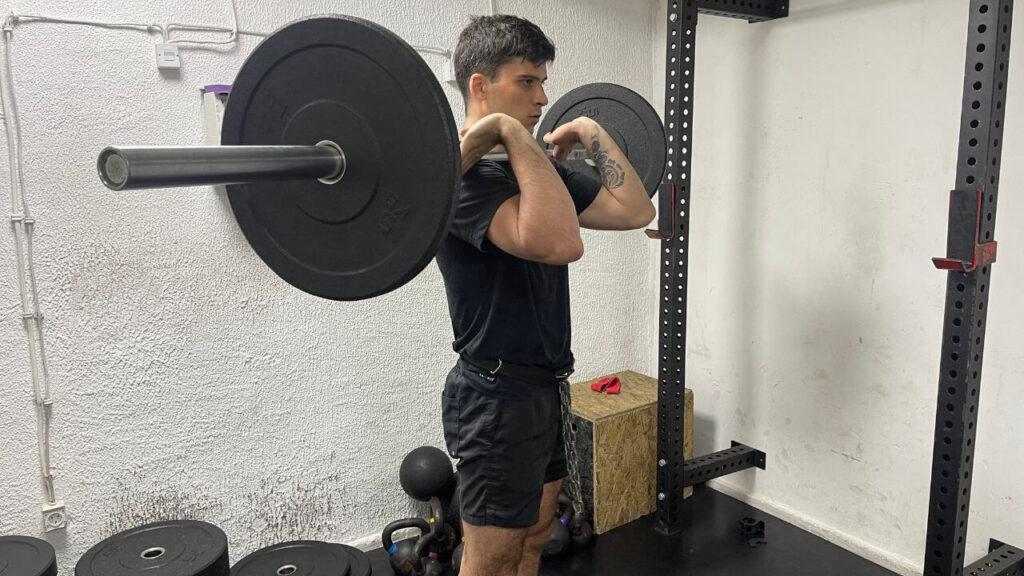
How to Perform Barbell Overhead Press
- Standing with your feet shoulder-width apart, rack the barbell on your upper chest.
- The palms of your hands should be facing front while you hold the bar with a slightly broader than shoulder-width grip.
- Extend your arms while keeping your elbows close as you press the barbell overhead.
- Once your arms are fully extended, lower the barbell back down to your upper chest.
This exercise helps improve the functional shoulder range of motion.
2. Half-Kneeling Landmine Press
The half-kneeling landmine press is a functional exercise that belongs to the vertical push movement pattern. This exercise is a staple in shoulder functional training programs.
It primarily works the shoulder muscles, notably the anterior and lateral deltoid, while also activating other upper-body muscles such as the triceps, core, and hip flexors.
For even more functional variation, try implementing standing single-arm landmine presses into your workout routine.
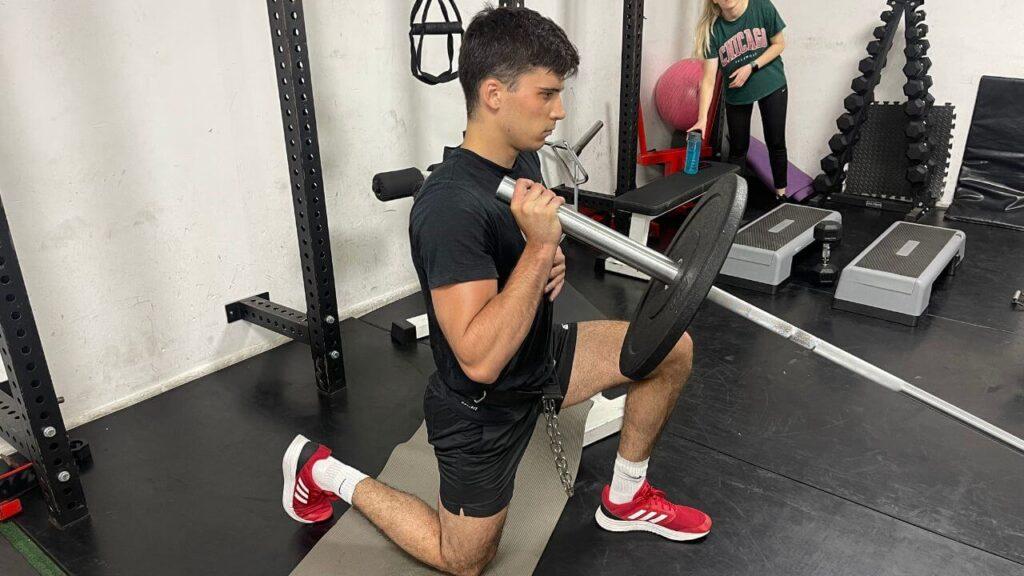
How to Perform Half-Kneeling Landmine Press
- Begin in a half-kneeling position, with your knee behind your hip and your ankle beneath your knee.
- Place the barbell slightly in front of your shoulder on the same side as the dropped knee.
- Lower the barbell to your shoulder and then straight up in the air.
3. Arnold Press
The Arnold press is a functional exercise that belongs to the vertical push movement pattern.
The Arnold press is named after the well-known bodybuilder and actor Arnold Schwarzenegger, who made the exercise more well-known by including it in his workouts.
It primarily works the deltoid, lateral deltoid, and rotator cuff muscles in the shoulders, as well as your triceps and upper chest, while also targeting other upper body muscles.

How to Perform Arnold Press
- Sit on a bench with back support and hold two dumbbells in front of you at around upper chest level with your hands facing your body and your elbows bent.
- Your arms should be next to your torso. The beginning posture should appear like the contracted section of a dumbbell curl.
- Push the dumbbells up with your hands facing ahead until your arms are stretched above.
- Rotate your wrists as you raise so that your palms face front at the peak of the exercise.
4. Push Press
The push press is a compound exercise from the vertical push movement pattern.
It focuses on the shoulders, specifically the anterior and lateral deltoids, as well as the triceps and upper chest.
Furthermore, the exercise’s explosive nature can aid to increase overall athletic performance and power production.

How to perform Push Press
- Begin by standing with your feet shoulder-width apart and an overhand grip on a barbell at shoulder height.
- Bend your knees slightly and drive the barbell upward, using the momentum created by your legs to assist you in pushing the weight up.
- Lower the barbell back down to your shoulders once your arms are completely extended and repeat for the appropriate amount of reps.
Incorporating single arm push press variations can add an extra challenge and enhance shoulder stability.
5. Bottoms-up Kettlebell Press
Bottoms-up kettlebell press is a challenging exercise that is a part of the vertical push movement pattern.
It primarily targets the triceps, upper chest, and shoulders, especially the rotator cuff muscles.
Starting with a small weight and maintaining perfect form throughout the movement is crucial since this exercise demands great stability and control.
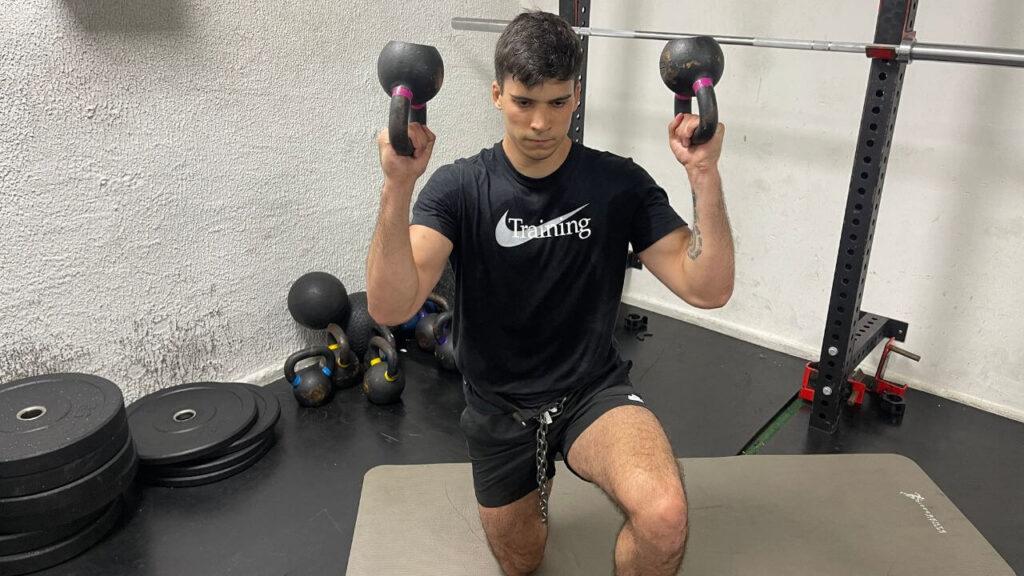
How to Perform Bottoms-up Kettlebell Press
- Begin by holding a kettlebell upside down in one hand, the handle in your palm, and the bell pointed up towards the ceiling.
- Standing with your feet hip-width apart (or half-kneeling) and your core engaged, push the kettlebell overhead straight up, maintaining your shoulder solid and your wrist straight.
- Return the kettlebell to its starting position and continue for the appropriate reps before switching to the opposite hand.
6. Wide-Grip Seated Row
The wide-grip seated row is an exercise that belongs to the horizontal pull movement pattern.
It predominantly works the rhomboids, trapezius, and latissimus dorsi, as well as the biceps, forearms, and shoulders.
This activity can help you improve your posture, strengthen your back, define your muscles, and boost general shoulder health.
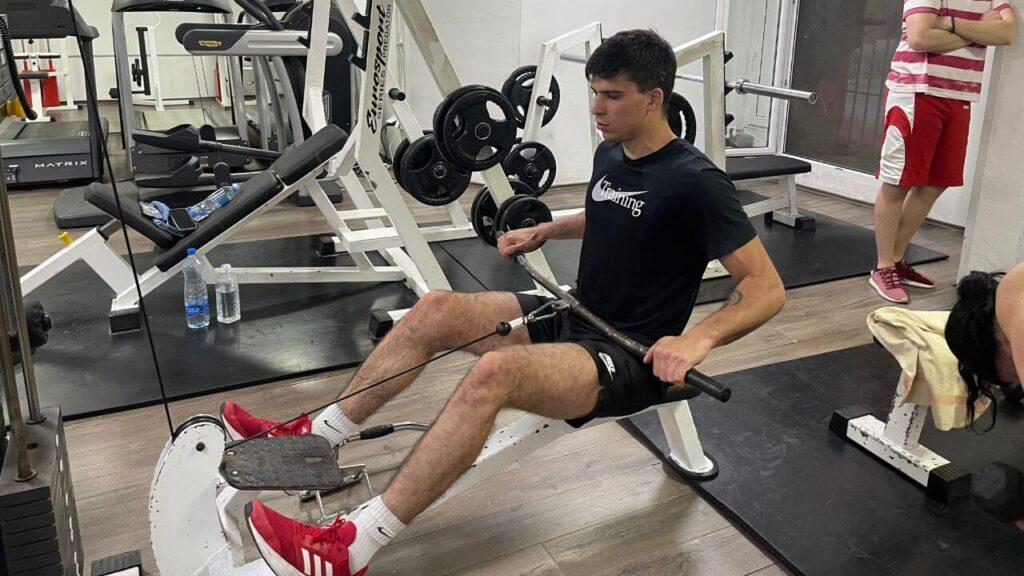
How to Perform Wide-Grip Seated Row
- Place your feet level on the floor and your knees slightly bent while sitting on a bench.
- Grab the barbell with an overhand hold that is broader than shoulder-width apart.
- Lean forward with your arms fully extended, maintaining your back straight.
- Pull the barbell towards your chest by retracting your shoulder blades and then slowly drop it back to the starting position.
7. Leaning Lateral Raise
The leaning lateral raise falls under a lateral rise movement pattern.
It primarily works the middle deltoid, but it also works the front and back deltoids as well as the trapezius muscles in the shoulders.
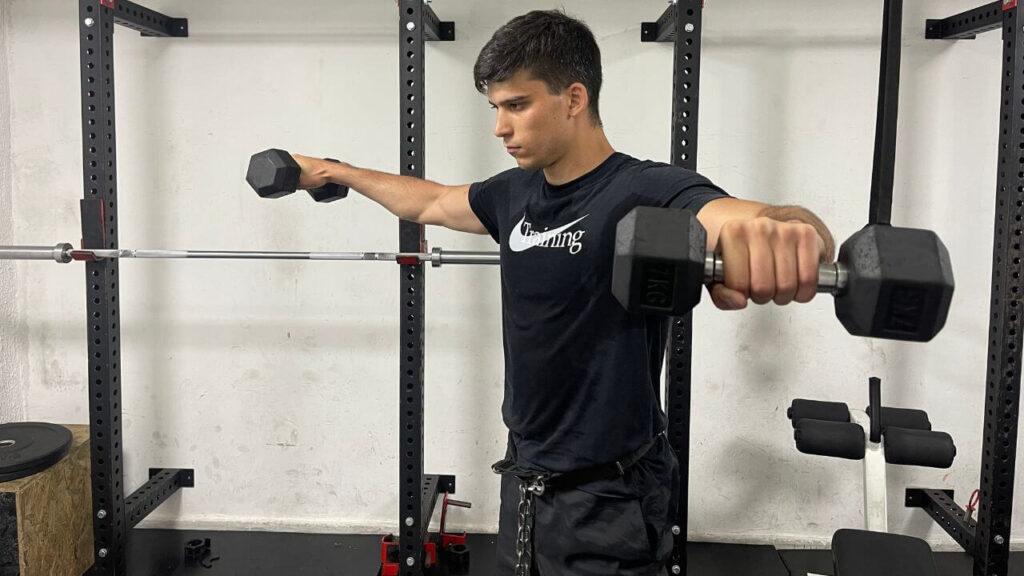
How to Perform Leaning Lateral Raise
- With a dumbbell in each hand with your palms facing in, stand with your feet shoulder-width apart.
- Bend to one side while maintaining your back straight and the dumbbells at arm’s length at your side.
- Lift the dumbbells out to the side slowly while maintaining your elbows slightly bent, until they reach shoulder height.
- Pause at the apex of the action before carefully lowering the weights to the starting position.
This is one of the functional activities for shoulder flexion that can greatly improve upper body strength.
8. Incline Y Raise
The incline Y raise is an excellent exercise for developing the upper back muscles, particularly the traps and rear deltoids, as well as the shoulder muscles.
It falls under the vertical rise movement pattern.
This exercise can aid with posture, shoulder stability, and scapular mobility.
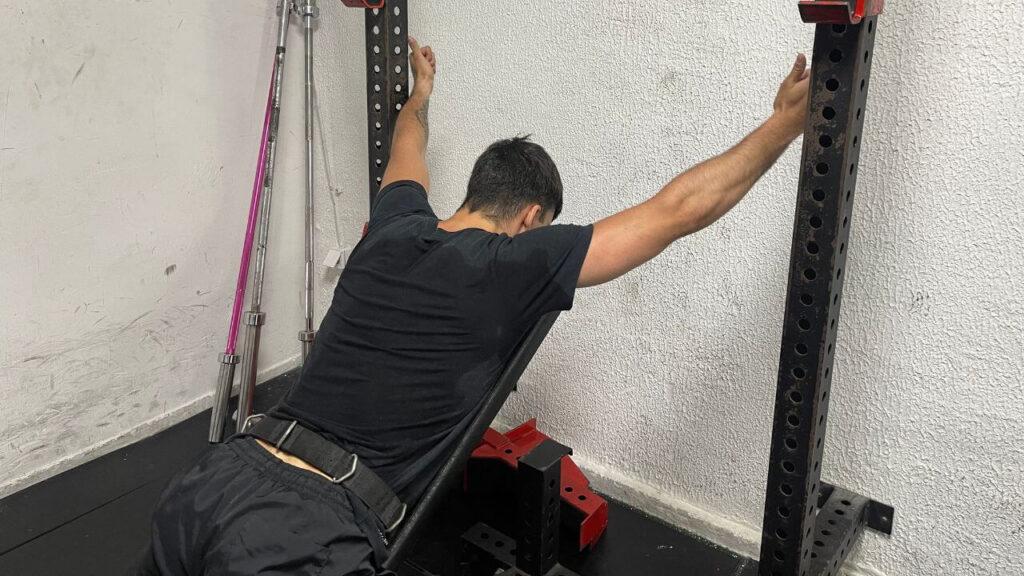
How to Perform Incline Y Raise
- Begin by adjusting an incline bench to a 45-degree angle.
- Lay face down on the bench with your arms straight down towards the floor and a light dumbbell in each hand.
- Lift your arms up and out to form a Y shape with your body, keeping your arms straight and shoulder blades pushed down and back.
- Pause slightly at the peak before lowering the weights with control.
9. Stability Bent-Over Dumbbell Rear Delt Raise
The stability bent-over dumbbell rear delt raise is a horizontal pulling movement pattern functional exercise.
This exercise primarily works the posterior deltoid muscles and the upper back trapezius and rhomboid muscles.
Do this exercise while standing on a BOSU ball or other unstable surface to provide a stability challenge.
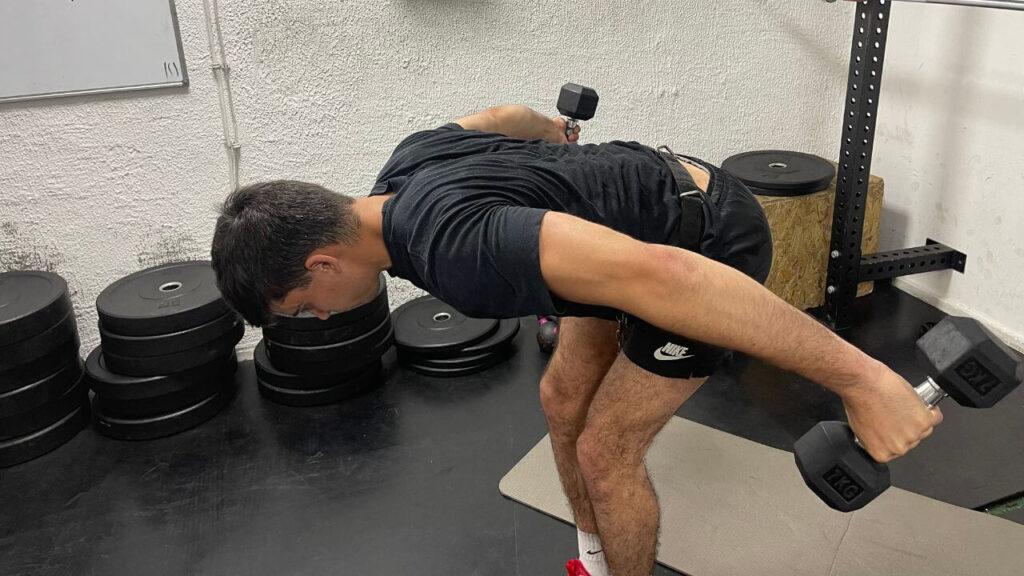
How to Perform Stability Bent-Over Dumbbell Rear Delt Raise
- Stand with your feet shoulder-width apart and an overhand grip on a set of dumbbells.
- Hinge forward from your hips, keeping your back flat and your core engaged, and gently bend your knees.
- Lift the dumbbells to your body’s sides, keeping your elbows straight and your shoulders down and back.
- After a brief pause at the top of the exercise, steadily drop the dumbbells down to the starting position.
10. Seated Dumbbell Shoulder Press
The seated dumbbell shoulder press is a compound exercise that falls under a vertical push movement pattern.
The deltoids (shoulder muscles) are the primary muscles used in this exercise, with the triceps and upper chest being included to a lesser level.
This exercise can enhance shoulder stability and mobility while increasing overall shoulder strength and size.

How to Perform Seated Dumbbell Shoulder Press
- Begin by sitting on a back-supporting bench and holding a dumbbell in each hand at shoulder height, palms facing front.
- Dumbbells should be raised until your arms are completely extended, then lowered to shoulder level.
- Maintain appropriate form and control throughout the action by keeping your elbows under your wrists.
11. Barbell Overhead Carry
The barbell overhead carry is a functional exercise that belongs to the carry (gait) movement pattern.
It focuses mainly on the shoulders, triceps, and upper back muscles.
This exercise can assist in increasing the strength of your upper body as a whole as well as the stability of your shoulders.
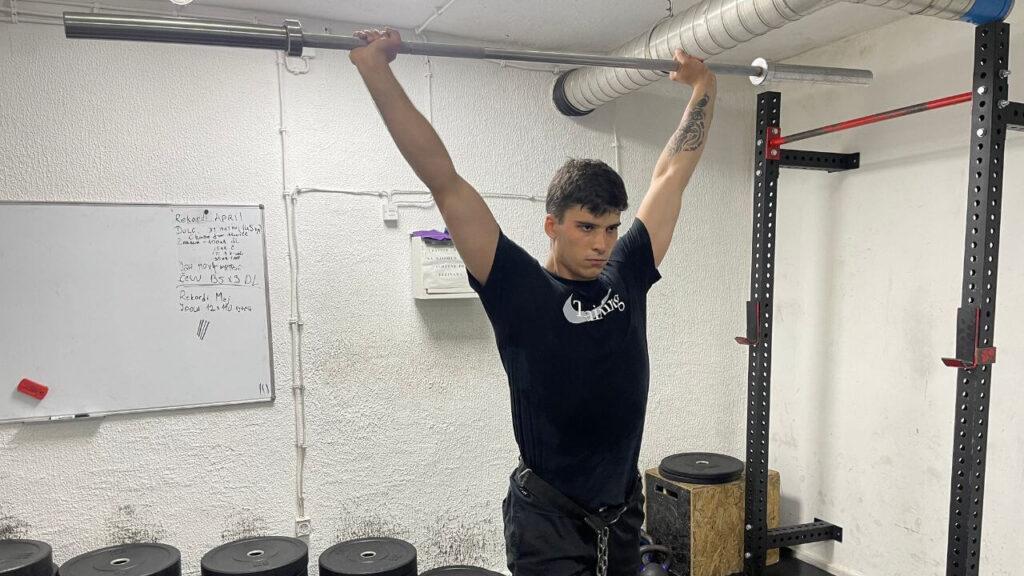
How to Perform Barbell Overhead Carry
- Start with a loaded barbell in a standing position with your arms fully extended overhead.
- Tighten your core and keep your shoulders down and back.
- Take small steps and walk forward, maintaining a stable overhead position with the barbell.
- Walk for a desired distance or time, then slowly lower the barbell to the starting position.
12. Dumbbell Lateral Raise Pause Set
The dumbbell lateral raise pause set is an exercise that focuses on shoulder abduction.
It primarily targets the medial deltoid muscle in your shoulders, but it also affects the anterior and posterior deltoids, as well as the trapezius.
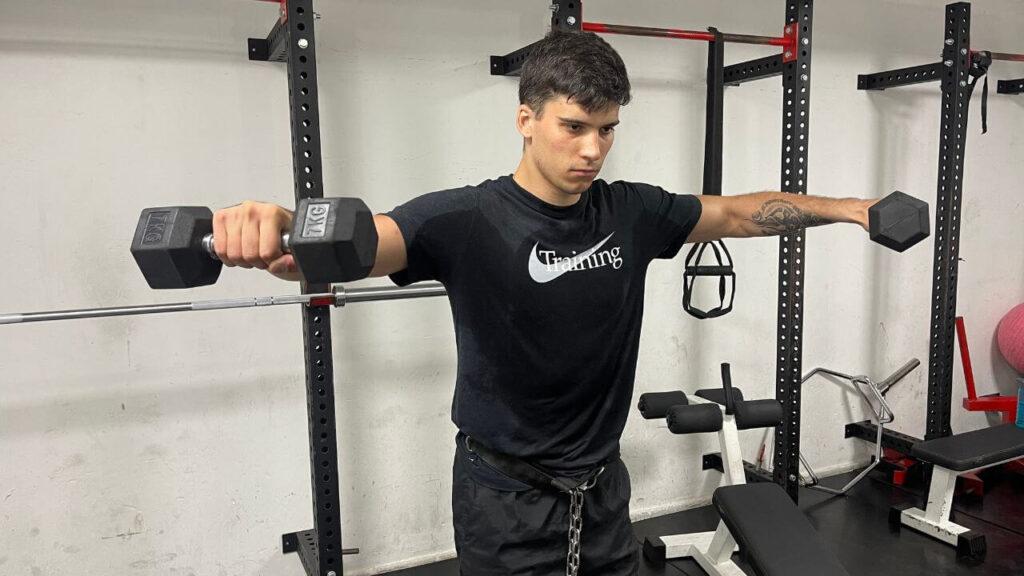
How to Perform Dumbbell Lateral Raise Pause Set
- Begin by standing shoulder-width apart with your feet shoulder-width apart and a set of dumbbells at your sides.
- Lift the dumbbells to your sides slowly, keeping your elbows slightly bent, and pause for 1-2 seconds at the top.
- Lower the dumbbells slowly back down and repeat for the appropriate amount of reps.
13. Single-Arm Push Press
The single-arm push press is a dynamic exercise that belongs to the vertical pushing movement pattern.
It primarily targets the shoulder muscles, specifically the anterior and medial deltoids, while also engaging the triceps, core, and upper chest muscles.

How to Perform Single-Arm Push Press
- Begin by holding a dumbbell in one hand and bringing it up to your shoulder.
- Bend your knees slightly, then drive the dumbbell above while extending your knees and hips explosively.
- Use the momentum created by your legs to assist in lifting the weight overhead.
- Lower the weight to your shoulder and repeat for the desired number of reps before switching arms.
- To avoid injuries, keep appropriate form and control throughout the movement.
14. Resistance Band Front Raise/Lateral Raise Combo
The resistance band front raise/lateral raise combo is a combination exercise that targets the front and lateral deltoids. It is a component of the shoulder flexion and abduction movement pattern.
The anterior deltoids are worked during the front raise portion of the exercise, while the middle (lateral) deltoids are performed during the lateral raise.
This exercise can help increase shoulder muscle activation, stabilize the shoulder, and strengthen the shoulder.
As it offers a wider range of motion than specific traditional shoulder exercises, it is also a suitable alternative for people with shoulder pain or mobility issues.
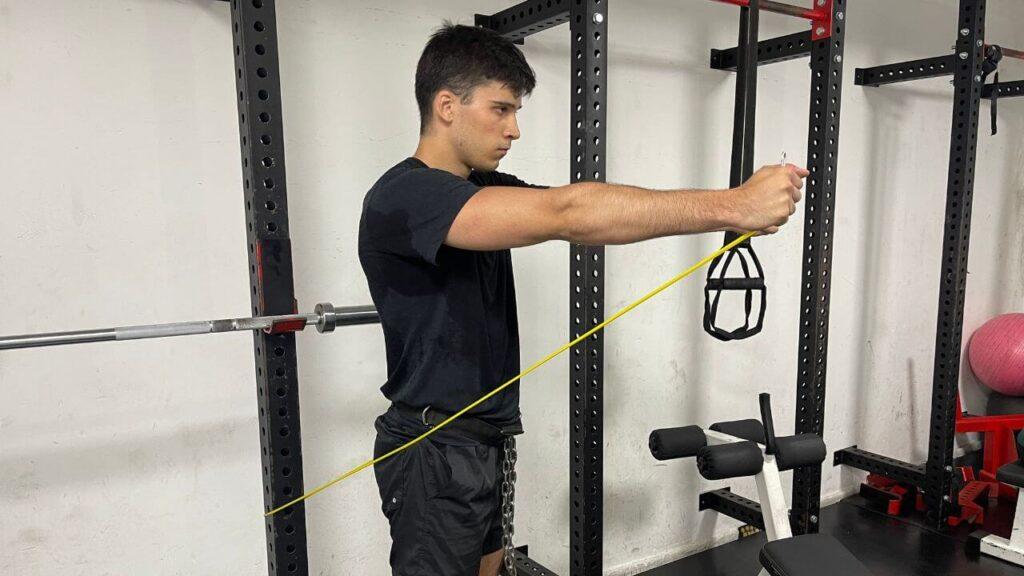
How to Perform Resistance Band Front Raise/Lateral Raise Combo
- Stand with your feet shoulder-width apart and grasp the resistance band handles with both hands.
- Begin with a front raise, bringing the band to shoulder height while keeping your arms straight. At the top of the exercise, pause briefly before transitioning to a lateral rise by bringing the band out to your sides with your elbows slightly bent.
- Pause again at the top of this movement before reversing the motion and returning to the starting position.
- Repeat until you’ve completed the required number of reps.
15. Cable Lateral Raise
The cable lateral raise is an exercise that targets the lateral deltoids, which are the muscles responsible for the rounded shape of the shoulders.
It is a part of the isolation movement pattern, which isolates one muscle group rather than using several.
It is a useful exercise for developing shoulder strength and hypertrophy because the cable maintains continuous strain throughout the range of motion.
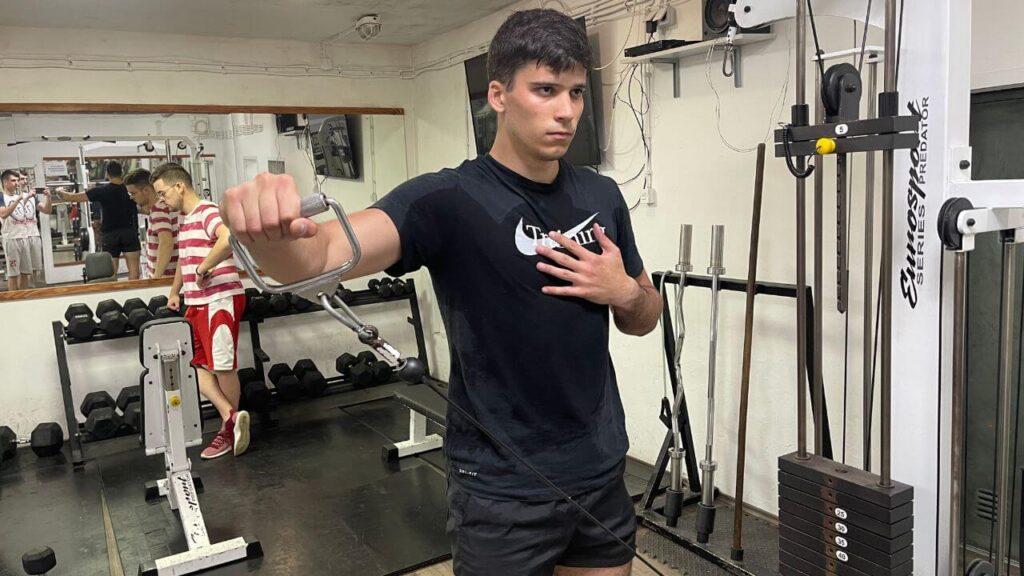
How to Perform Cable Lateral Raise
- Stand with your feet shoulder-width apart and your left hand on the cable machine’s handle. For stability, lay your right hand on your hip or the machine.
- Maintain a tiny bend in your elbow and extend your left arm straight to your side, keeping your wrist aligned with your elbow.
- Keep your shoulder blade down and your elbow at the same height as your shoulder when you raise your arm.
- After briefly pausing at the top of the movement, carefully drop the weight back to the starting position.
- Rep the required number of times before moving to the opposite arm.
Expert Shares Tips on Functional Training for Bigger and Stronger Shoulders
In a YouTube video, Adam Sinicki, a certified personal trainer and founder of The Bioneer YouTube channel, discusses the benefits of functional training for shoulder development, highlighting the importance of varied exercises for both strength and aesthetics:
“If you do hybrid and functional training right, they’re actually great for hypertrophy so you don’t have to choose between looks and function. I’ve been doing windmills, hangs, heavy bag work, handstand practice, and pike push-ups, all of which contribute to shoulder strength, mobility, and size. These exercises ensure that the shoulders are stable and strong in every position, covering every base and sending lots of signals to encourage growth. This approach combines frequency, volume, and intensity, making it suitable for anyone looking to improve their shoulder health and appearance.”
What Are Functional Exercises?
Functional exercises imitate or emulate real-life activities or motions, such as lifting, carrying, pushing, tugging, and twisting. These physical activities prepare the body to carry out daily chores more quickly, easily, and safely.
Functional exercises often involve several joints and muscle groups and call for the utilization of balance, coordination, agility, and core stabilization.
Functional exercises can help with daily activities, injury prevention, enhancing general fitness, functional movement, and athletic performance.
These exercises can be employed in physical therapy and rehabilitation settings, along with general fitness and sports performance training [2]. Functional exercises for shoulder health are crucial for comprehensive rehabilitation programs.
Exercises that are considered to be functional include squats, lunges, deadlifts, push-ups, pull-ups, planks, kettlebell swings, medicine ball tosses, and many more.
You can perform these exercises with your bodyweight, resistance bands, dumbbells, barbells, kettlebells, or other tools.
Rotator Cuff and Shoulder Conditioning Program
The rotator cuff is a collection of tendons and muscles surrounding the shoulder joint and helps stabilize and control movement.
Because of its high degree of mobility, the shoulder joint is prone to injury and is readily strained or damaged, particularly in athletes and people who engage in overhead activities.
In addition to promoting recovery and rehabilitation following an injury, a rotator cuff and shoulder conditioning program can assist in avoiding damage.
The program frequently includes exercises that strengthen the rotator cuff muscles, increase mobility and flexibility, and improve shoulder stability [3].
Pendulum
A shoulder rehabilitation exercise called the “pendulum” increases shoulder strength, mobility, and stability.
It primarily targets the rotator cuff muscles, which support shoulder stability and facilitate fluid arm movement.
The pendulum exercise tests the rotator cuff muscles’ ability to stabilize and govern the shoulder joint by having the arm move like a pendulum while holding a weight or resistance band.
This exercise can aid in the prevention and treatment of shoulder ailments such as rotator cuff tears, impingement syndrome, and instability.
Crossover Arm Stretch
The crossover arm stretch is a stretching exercise focusing on the shoulders, chest, and upper back muscles.
One arm is crossed over the body to stretch the shoulder and chest muscles, and the other is gently pulled toward the chest.
This exercise is within the static stretching category, which involves stretching the muscles while holding them in a fixed position for a while.
In addition to enhancing posture and increasing shoulder range of motion, this exercise can relieve tightness and discomfort in the shoulders and upper back.
Passive Internal Rotation
A shoulder mobility exercise called passive internal rotation includes turning the humerus bone inward and toward the body while maintaining a fixed position for the elbow and forearm.
Usually, this activity is carried out with a partner, a therapist, or a self-assistance method.
The passive internal rotation exercise is intended to increase the range of motion in the shoulder joint, especially in the inner rotation direction.
Athletes or anyone who needs a lot of shoulder mobility for their sport or regular activities may find this helpful.
Additionally, imbalances or tightness in the shoulder joint, which can aggravate discomfort or dysfunction, can be treated with this exercise.
Passive External Rotation
Stretching exercises called passive external rotations are frequently utilized in shoulder conditioning and rehabilitation regimens.
This exercise aims to increase the shoulder joint’s flexibility and range of motion, especially during external rotation.
The person performs the exercise while lying on their back with their arm by their side and their elbow bent 90 degrees.
This is a passive movement, meaning that the individual does not actively move their arm but instead allows the therapist or partner to move it for them.
Sleeper Stretch
The sleeper stretch is a shoulder stretch that targets the rotator cuff muscles, specifically the subscapularis muscle.
This stretch is frequently applied in rehabilitation settings to increase shoulder flexibility and mobility and prevent or treat rotator cuff problems.
To do the stretch, lie on your side with the injured arm resting on a foam roller or towel that has been rolled up.
Your forearm should be perpendicular to your body, and your elbow should be bent 90 degrees.
From here, you slowly push your affected hand toward the ground by applying pressure on the back of it with your other hand.
This stretch can be performed multiple times daily for 15 to 30 seconds, then gradually advanced as tolerated.
Standing Row
An excellent exercise for shoulder fitness and strengthening is the standing row. It entails using the upper back and shoulder muscles to pull the weight toward the body while standing.
The rhomboids, trapezius, and rear deltoids, all crucial muscles involved in stabilizing the shoulder joint and upholding good posture, are especially well-targeted by this exercise.
In addition to working the upper back and shoulders, the standing row exercise can increase scapular stability and mobility. T
his exercise, when done correctly, can help lower the risk of shoulder injuries, enhance posture, and increase the strength and range of motion in the shoulders as a whole.
External Rotation With Arm Abducted 90°
External rotation with the arm abducted 90° is an effective exercise for strengthening the rotator cuff muscles and improving shoulder stability.
The infraspinatus and teres minor muscles, two of the four rotator cuff muscles in charge of external rotation of the shoulder joint, are the focus of this exercise.
This exercise can enhance total shoulder strength and mobility while preventing and treating rotator cuff issues.
It should be incorporated into a comprehensive shoulder training program.
It is frequently advised for people with a history of shoulder problems or weakness and players who participate in overhead activities like baseball, tennis, and swimming.
Internal Rotation
Internal Rotation exercise specifically targets the subscapularis muscle, one of the four rotator cuff muscles responsible for the internal rotation of the shoulder joint.
In particular, subscapularis strength can enhance overall shoulder stability and lower the chance of injury for athletes that take part in overhead sports or weightlifting.
It’s common for people to have overdeveloped chest and shoulder muscles, which can cause the shoulders to drop and cause rounded postures.
You can work to balance out this imbalance and enhance the health of your shoulders in general by strengthening the subscapularis and other internal rotators.
External Rotation
External rotation targets the muscles of the rotator cuff, particularly the infraspinatus and teres minor, which are responsible for the external rotation of the shoulder joint.
With or without resistance, external rotation exercises can be done.
When applying resistance, it’s typical to utilize a dumbbell or band to create external resistance against the arm’s rotating action.
Aside from standing, sitting, and lying down, this exercise can also be done in various other postures.
Elbow Flexion
Elbow flexion exercises can help the conditioning and strengthening of the rotator cuff and shoulder muscles.
These exercises often entail flexing the elbow joint while maintaining the upper arm still.
They can be done with resistance bands, dumbbells, or cables.
These exercises can indirectly support the shoulder joint and the rotator cuff muscles by strengthening the muscles responsible for elbow flexions, such as the biceps brachii and brachialis.
Exercises that target all of the muscles involved in shoulder movement and stability, including those engaged in elbow flexion, should be a part of any comprehensive functional fitness program.
Elbow Extension
Elbow extension exercises aim to strengthen the triceps brachii muscle, which is responsible for extending the elbow joint.
Many daily tasks that entail pushing, pulling, or lifting require strong triceps.
Exercises for elbow extension can also aid with posture and lower the risk of the rotator cuff and nearby muscle injuries.
Enhancing triceps strength can help avoid compensatory movements that might cause shoulder and upper back pain.
Trapezius Strengthening
The trapezius muscle is crucial for the stability and movement of the shoulder.
Exercises that target the trapezius muscles can be incorporated into a rotator cuff and shoulder training program to enhance shoulder function and stability.
The prone Y, T, and W exercises, scapular retractions, and shrugs can all target the trapezius muscle.
By strengthening the muscles in the upper back and enhancing scapular stability, these exercises can lower the risk of shoulder injuries and improve shoulder function in general.
Scapula Setting
The Scapula Setting exercise targets the rhomboids, trapezius, and serratus anterior muscles, which are essential for maintaining scapular stability.
Together, these muscles help keep the shoulder blades’ proper alignment and limit their excessive movement when the arms are raised and lowered.
Concentrating on good form and control is crucial when completing the Scapula Setting exercise.
The goal of this exercise, usually carried out just with body weight, is to contract and depress the shoulder blades to engage the muscles that keep them together.
Scapular Retraction/Protraction
The scapular retraction/protraction exercise aims to build up the shoulder blade-movement-controlling muscles, which are crucial for stable and effective shoulder movement.
By drawing back or pushing forward with the arms at the sides or in front of the body, the shoulder blades are controlled and manipulated throughout this exercise.
In addition to the serratus anterior muscle, which protects the shoulder blades, this movement also assists in engaging the rhomboids and middle trapezius muscles, which draw the shoulder blades together and down.
Bent-Over Horizontal Abduction
The Bent-Over Horizontal Abduction exercise focuses on the posterior deltoid muscle, which is crucial for shoulder joint stability during overhead motions.
The posterior deltoid can be strengthened to improve shoulder stability and lessen the chance of rotator cuff injuries.
In addition, this exercise works the trapezius and rhomboid muscles, both of which are crucial for scapular stability and appropriate shoulder mechanics.
A balanced and thorough shoulder conditioning program frequently combines the Bent-Over Horizontal Abduction exercise with other moves.
4 Functional Shoulder Exercises to Improve Mobility
Maintaining proper posture, minimizing pain, and boosting upper body function depends on having more mobile shoulders.
Functional shoulder exercises can help you improve your range of motion, flexibility, and strength.
This section will go over four efficient shoulder mobility and functional exercises [4].
1. Wall Extensions
Exercises like wall extensions are good for enhancing posture and shoulder mobility.
This exercise strengthens and stretches the muscles in the upper back.
Additionally, it encourages appropriate shoulder alignment and enhances scapular stabilization.
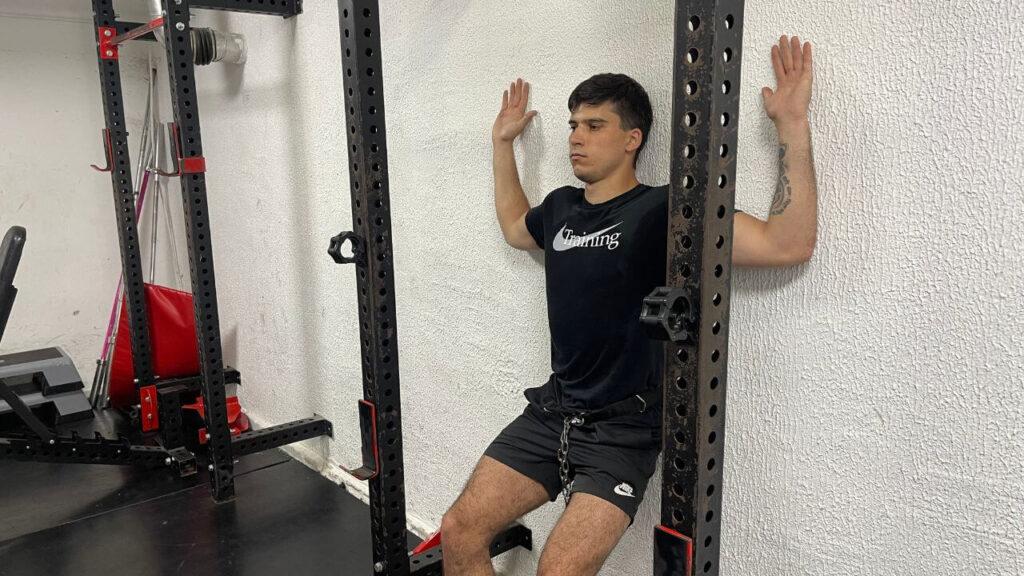
How to Perform Wall Extensions
- Place your back to a wall and your feet shoulder-width apart.
- Put your palms up against the wall, fingers pointing upwards.
- Maintain straight elbows and relaxed shoulders.
- Move your arms up the wall slowly, keeping your elbows straight until your hands are above your head. As you reach up, keep your shoulder blades down and back.
- Hold for a few seconds before lowering your arms to the beginning position.
2. Doorway Stretch
The doorway stretch is a simple but effective exercise that targets the pectoral muscles and the anterior deltoid, which tend to get tight and restricted with prolonged sitting and poor posture.
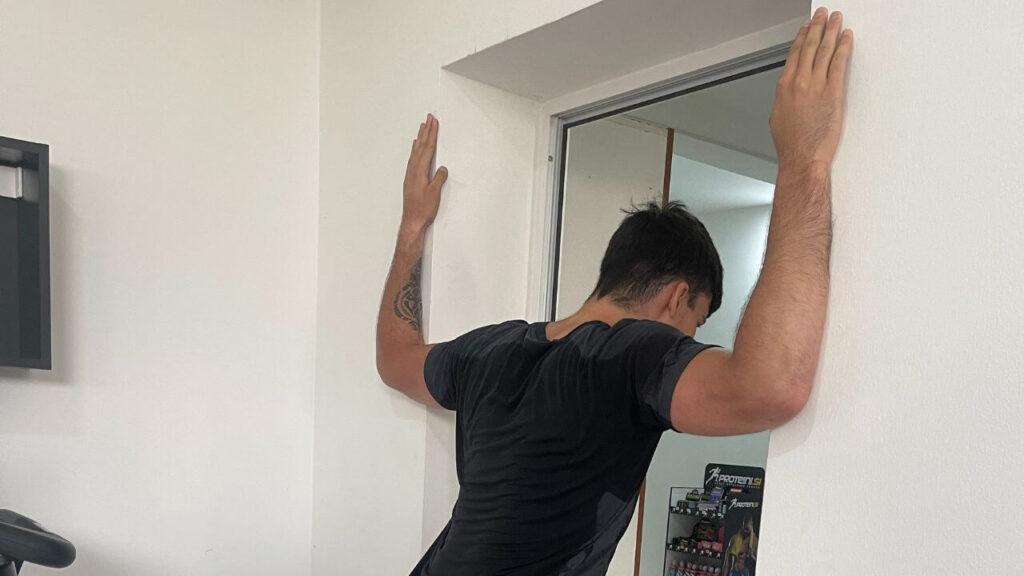
How to Perform Doorway Stretch
- Stand with your feet hip-width apart in a doorway.
- Place your hands on the door frame, elbows bent 90 degrees, and upper arm (humerus bone) parallel to the floor.
- Take a step forward with one foot to stretch your chest and shoulders.
- Hold the stretch for 20-30 seconds, then return to the beginning position and do the opposite side.
3. Lat Focus With Band Traction
Lat focus with band traction is a functional exercise that improves shoulder mobility by stretching and strengthening the latissimus dorsi muscle.
This exercise uses resistance bands to create traction in the shoulder joint.
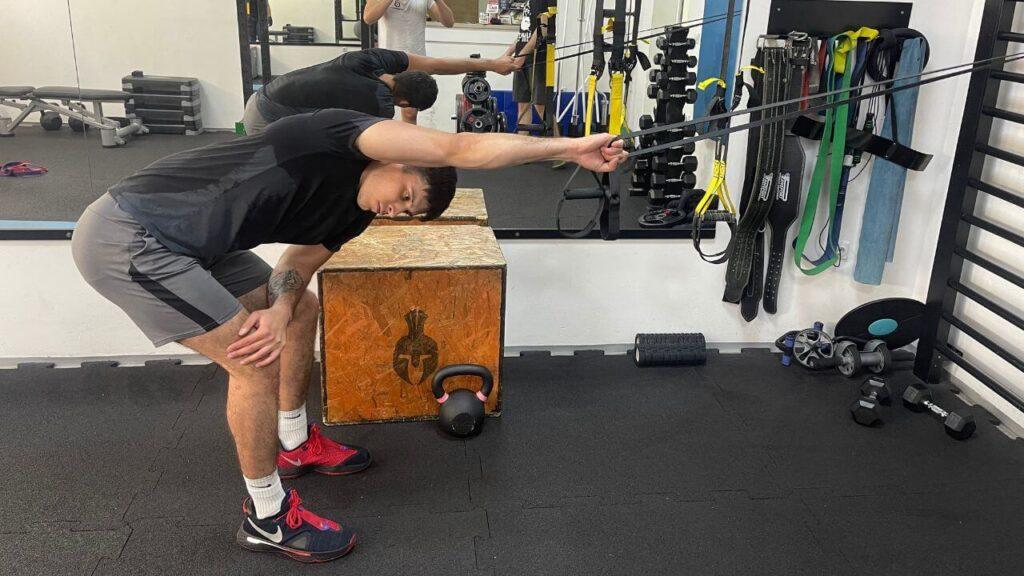
How to Perform Lat Focus With Band Traction
- Connect a resistance band to a strong anchor point, such as a door handle or a pole.
- Face the anchor point and grip the band with both hands, arms straight and shoulder-width apart.
- Step back until you feel the tension in the band, then draw your shoulder blades down and back.
- From here, steadily bring the band towards your hips while keeping your spine straight and shoulder blades engaged.
- Hold for a few seconds before progressively relaxing and returning to the beginning position.
4. Two-Arm Rows
Two-arm rows are effective for improving shoulder mobility and strengthening the upper back muscles. This exercise can also help to improve posture and reduce the risk of injury to the shoulders and upper back.

How to Perform Two-Arm Rows
- Stand with your feet shoulder-width apart and hold the dumbbells or barbell with an overhand grip.
- Bend your knees slightly and hinge at the hips, keeping your back straight.
- Keep your elbows close as you pull the weight towards your chest, squeezing your shoulder blades together.
- Pause momentarily at the movement’s top, then slowly lower the weight to the starting position.
- Repeat for the desired number of reps.
Related Articles:
- 10 Best Functional Upper Body Exercises for Strength
- 10 Functional Arm Exercises for Size & Performance
- 7 Best Functional Chest Exercises and Workouts
FAQs
What Are Functional Shoulder Tasks?
Functional shoulder tasks are motions or activities that call for the efficient and coordinated use of the shoulder joint and surrounding muscles.
How Do You Build Strong Functional Shoulders?
You build strong functional shoulders by using a variety of exercises that target the rotator cuff, scapular stabilizers, and surrounding muscle groups.
What Is a Functional Exercise for Shoulder Abduction?
Functional exercise for shoulder abduction is one that involves movement patterns and muscle activations that replicate real-life activities that necessitate raising the arms out to the side of the body.
What Is a Functional Exercise for Shoulder Flexion?
Functional exercise for shoulder flexion is any exercise that involves moving the arms forward and upward in a manner that simulates real-life movements.
What Are the 6 Types of Shoulder Movements?
The 6 types of shoulder movements are: flexion, internal rotation, external rotation, adduction, abduction, and extension.
What Is the Best Functional Shoulder Exercise for Mobility?
The wall extension stands out as a top choice for the best functional shoulder exercise for enhancing mobility.
For maintaining proper posture and avoiding shoulder injuries, the muscles that control shoulder extension and scapular retraction are the focus of this exercise.
You may effectively increase your range of motion and enhance your shoulder health by regularly including this exercise in your shoulder fitness program.
Remember to consult a healthcare expert before beginning any new exercise regimen to ensure safety and efficacy.
Start Building Your Dream Body Today
Ready to elevate your fitness game without falling into the trap of dull, repetitive routines that just don’t deliver? Imagine sculpting your ideal physique and boosting your health, all while still enjoying life’s pleasures, like those irresistible weekend getaways and your aunt’s legendary cheesecake. With our online fitness and nutrition coaching service, you don’t have to compromise. Dive into a personalized fitness journey that blends perfectly with your lifestyle, not against it. Book your completely free discovery consultation today, and take the first step towards a transformation that doesn’t require giving up the joys of life.

“I was skeptical about online fitness coaching, but Functional Body Savage completely changed my perspective. Vanja and Radomir’s personalized approach and attention to detail have helped me achieve goals I never thought possible. I’m stronger, more confident, and grateful for their guidance.”
Emily Thompson, San Francisco, CA
Learn More About Our Online Coaching ServiceReferences:
- https://www.ncbi.nlm.nih.gov/pmc/articles/PMC3881455/
- https://www.frontiersin.org/articles/10.3389/fphys.2021.738878/full
- https://www.ncbi.nlm.nih.gov/pmc/articles/PMC7646354/
- https://www.ncbi.nlm.nih.gov/pmc/articles/PMC6692706/

